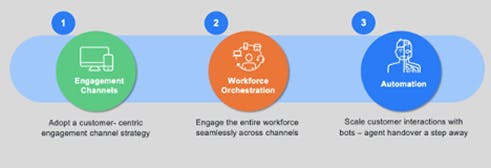Building a Modern Customer Engagement Strategy with Channel Automation


Your customers expect you to engage with them on whatever channel they reach out. The challenge is that those customers expect an effortless experience, regardless of the channel.
Organizations need a new approach that allows them to not only meet customer expectations as interaction volume grows, but also make it possible for brands to engage in a truly omnichannel manner. And, as recent research shows, customers are increasingly likely to look for service through convenient and asynchronous channels.
In Verint’s “State of Digital Customer Experience” report, 56 percent of those surveyed under the age of 45 said they prefer to ask questions on digital engagement channels rather than traditional channels. This segment of the population is only going to grow, meaning organizations need to invest now to meet this demand, and to level-up their technology to meet expectations.
Verint’s new Channel Automation offering enables organizations to scale their customer engagement strategy through a combination of digital channels, workforce orchestration, and automation. It allows a brand to deploy resources – humans and bots – flexibly across channels with lower costs and less effort to deliver excellent customer experiences.
There are three steps to achieving a digital-first engagement strategy:

Adopt a Customer-Centric Channel Engagement Strategy
The first step in achieving a digital-first strategy is to connect with your customers on their terms. Your customer service needs to scale with the needs of your customers and the channels they prefer – that could be adding five channels, or just one, depending on your goals.
The key is to deliver asynchronous engagement options. These include email, live chat, Facebook Messenger, WhatsApp, Twitter and more via a unified agent UI that allows the workforce to work seamlessly across channels.
This isn’t, however, a static strategy. A brand can (and should) choose which combination of channels are most appropriate for their customer engagement strategy and add additional channels as necessary. That’s why Channel Automation is intended to scale and evolve with your organization’s needs, and those of your customers.
Engage the Workforce Across Channels
The second step toward a digital-first strategy is ensuring your teams are ready and able to work with an omnichannel engagement strategy. When done incorrectly, adding more channels can create workforce silos and a disjointed support experience (and stressed-out employees).
Channel Automation goes beyond simple call routing by connecting related interactions across channels, for a seamless customer – and employee – experience. This allows staff to work across multiple channels, elevating individual customer interactions into connected engagements, even if the customer journey spans various touch points.
This fluid strategy also makes any agent the right agent while increasing contact center flexibility and capacity.
Scale Customer Interactions Through Automation for Real ROI
Then, there’s the final step: automation. This involves integrating bots into your workforce to scale customer interactions. Channel Automation from Verint includes scalable conversational AI that can handle common customer inquiries across all channels, with agent handover only a step away.
Here’s how you’ll benefit from Channel Automation:
- Lower cost-per-contact: Bot-ready platforms that combine both adaptive automation and agent-assisted service result in fewer inquiries needing a human response—and leave highly skilled agents free to handle more complex customer service needs. In fact, one of our customers saw a 40 percent reduction in cost-per-contact soon after deployment.
- Deliver better customer service experiences: Automation of customer service inquiries typically results in quicker response and resolution times for customers, decreasing service effort and increasing customer loyalty.
- Meet capacity through conversation containment: Service bots and virtual assistants help brands manage high-volume, low-effort queries. Used as a frontline triage, bots should resolve repetitive, simple issues while highly skilled agents are dedicated to high-value interactions—creating big savings in customer service costs. One of our customers recently enjoyed a 78 percent bot containment rate, leading to meaningful savings and better operations.
Learn more about Channel Automation right here.